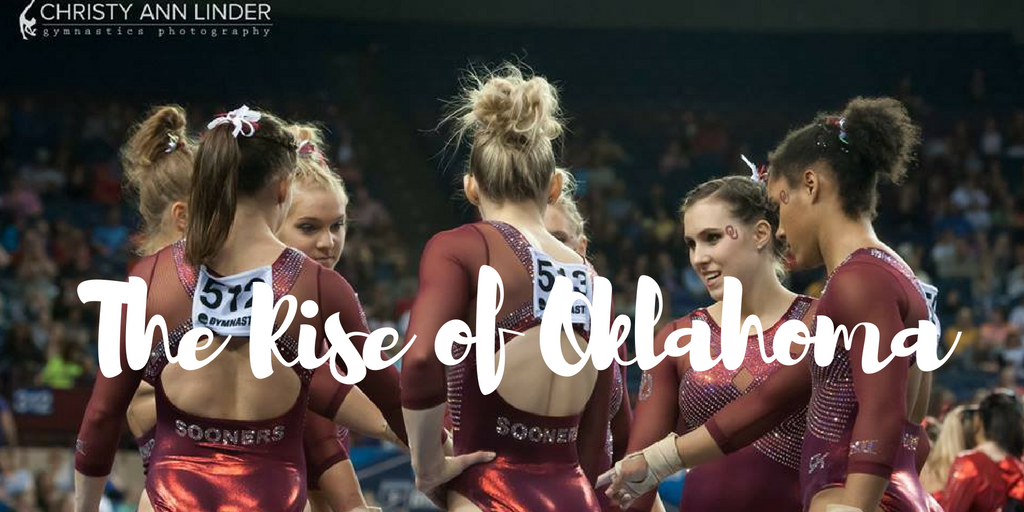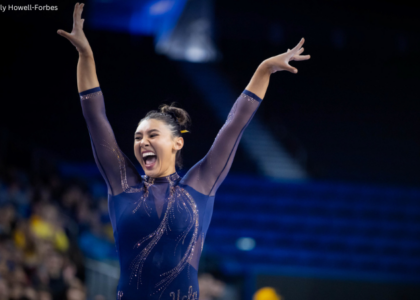The Oklahoma program has grown progressively stronger since its humble beginning in 1981. Paul Ziert was the coach of both the men and women’s program and only a high school gymnastics coach when he was hired to take over the program. And the Sooners were short on facilities as well, practicing in an old movie theater with a leaky ceiling.
It was endanger of being cut before he took the reigns, but in the late ‘70s, he recruited and coached Bart Conner to two national championships. The arrival of Conner turned the sport of gymnastics into an emphasis in Norman, Okla., and the team received more attention.
Steve Nunno, who is most known as the personal coach of Shannon Miller, earned the head coach title in 2001 until Iowa State’s K.J Kindler came in and transformed the Sooners into the dominant, artistic and unstoppable defending national champions they are today.
This does not happen overnight. In fact, it was not until 2010 that Oklahoma made it to the Super Six for the first time. The program has had 64 All Americans, 11 conference titles and 13 NCAA championship appearances. During this time period, the gymnasts’ individual scores have also risen. As more individuals finished in the top 25 on each event, the higher the team scores grew. This allowed it to place higher and ultimately win competitions.
|
The most noticeable change occurred between 1998 and 2006. At the end of the season the Sooners were ranked only No. 28 in the country with a Regional Qualifying Score of 193.181 with their high score for the year a 195.400. But if the team is not consistently hitting its routines, a score like this becomes a fluke and not standard. That year just one gymnast was ranked in the top 25 — Ginger Russell, who was tied for No. 23 in the all-around, as well as for No. 21 on beam. Three years later in 2001, Switzer’s final year saw the team finish No. 19 nationally with an RQS of 195.765 — 2.584 points higher than where it finished three years prior. It also saw a nine-spot rise in the rankings. Its sole competitor to finish ranked in the top 25 was all arounder Leticia Ishii. The Sooners jumped into |
Steve Nunno, the previous assistant and co-head coach was now the sole head coach. His goal was to make Oklahoma a top program and to secure its first national title. He was responsible for winning the 2004 Big 12 title, and in 2005, he had equaled the school record for the most wins at 19. He had a great deal of experience with USA Gymnastics over the years, which had a huge benefit to the team.
During the time Nunno was there, Nebraska and Iowa State were the Sooners biggest competition. In 2003 Nunno led the team to a record five consecutive scores over 197. This was the first time in OU school history that it consistently scored above the benchmark total. However, it fell short at regionals and did not make nationals that year.
The Sooners finished 2006 with an RQS 196.335, an increase of over half a point from their 2001 final RQS. Individually, they finished with two all arounders ranked in the top 20, three vaulters ranked in the top 25, Brittney Koncak Schumann tied for No. 22 on bars, top 13 as a team on beam and had two gymnasts in the top 25 on floor. Schumann was also ranked in the top six in the all around.
K.J Kindler took over in 2007 and has made the program what it is now. The previous coaches laid the foundation, so she hit the ground running and never looked back. Kindler was the assistant coach at her alma mater Iowa State for nine seasons and head coach for six, leading the Cyclones to their only Super Six appearance. She became the only coach to ever take two different teams to the Super Six in 2011 when the Sooners qualified for the first time, finishing third and inside the top 10 on all four events.
2016 saw Oklahoma win its second national championship. With an impressive RQS of 197.920, it finished in the top three on every event, holding the No. 1 spot on bars, beam and floor while sharing the No. 3 spot on vault with Georgia. Chayse Capps finished ranked second in the all around with Keeley Kmieciak finishing in 14th. Three Sooners ranked in the top 25 on vault, four in the top 12 on bars, two in the top eight on beam and four in the top 25 on floor.
Even though the Sooners will be graduating some key players, the foundation has been laid for years to come. They have the talent of world champion Maggie Nichols, and Brenna Dowell will return from her deferral. All signs point to Oklahoma continuing to rise.



